#TitBird
Explore tagged Tumblr posts
Text

2 notes
·
View notes
Text
Great Tit Bird introduction and Overview


Great Tit Bird in Jungle
Great Tit (EU) — Bird Note
The Great Tit Bird (Parus major) is a familiar passerine bird. Look for its black head and neck, white cheeks, olive upperparts, and yellow underparts. This bird is very adaptable. It thrives in many places, like woodlands, forests, parks, gardens, and urban areas. The great tit is a passerine bird in the tit family, Paridae. It lives in Europe, the Middle East, and Central Asia. You can also find it in the Palearctic region, up to the Amur River, and in some parts of North Africa. This bird thrives in almost any forested area. Only during very harsh winters do most great tits migrate. The Great tit has a black head and neck. It also features white cheeks, olive upper parts, and yellow underparts. There are a few other differences among the many subspecies.
Great Tit Diet
In summer, its primary food is insects. In winter, they eat a more varied diet. This includes small hibernating bats. In addition to insects, they would also treat themselves to seeds, nuts, berries and buds. Black sunflower seeds, sunflower hearts, and peanuts in a mesh feeder attract colorful birds to your backyard. Suet blocks and suet fat balls also help bring them in.
Great Tit Bird Song
They are very vocal birds, and you can hear their bird song year-round. And there are a lot of different sounds they can make. In fact, male Great Tits can produce up to 40 different sounds! Their sweet chirps consist of repeated two-note phrases. That's why some sounds like'Tea-cher, tea-cher'. عوذ / عوذهم ( ال)", Sometimes it is also played with three notes. Great Tits have a variety of unique sounds, including whistles and chirping sounds, as well as loud aggressive noises. 📝Basic Info Scientific Name: Parus major Lifespan: around three years Size: 4.9-5.5 inches Weight: 0.49–0.77 ounces Wingspan: 8.85–10.03 inches
Ref=Distribution: foods/guardians the great tit.
They’re the most widespread in the UK, except for some northern and western Scottish islands. Great Tits also range in central Asia, southern Russia, and northwest Africa. They are replaced by the Japanese Tit in East Asia or the Cinereous Tit in South Asia. Great Tits used to live in forests. Now, they can be found in parks, gardens, and other areas with similar plants.
Great Tit Breeding
The great tits are a loyal bird, monogamous with separate areas for nesting and raising baby. These territories develop in late January and great tits begin to defend territories in late winter/early spring. All this and in the coming years, reclaim and restructure these ${({}) territories once more. Great tits may nest in holes, typically in trees but sometimes walls or rocks. They are also going to use nest boxes for homes. The female constructs a nest within a tree cavity. Its made with plant fibers, grass, moss, hair, wool and feathers she uses. The clutch number can be quite large, up to 18, but the usual range is between five and twelve. The eggs themselves are white, with red spots. She keeps the eggs warm (the father bird brings her food).
Climate Change
Great tits showed strong decline due to climate crisis even it is a species with only population over 300 million. The great tit is an insect-eating bird. Its breeding season lines up with when caterpillars are most available. This timing helps them feed their young. A new study on great tits finds that quick climate change leads to warmer winters and earlier springs. This change also leads to caterpillars being available sooner. But great tits require more time to adjust to that shift. Many are unable to procure enough food for the chicks before the bug bounty is spent (Harrison et al. 2015), so the chicks will have a harder time surviving and growing up (and thus population numbers are affected much more). If populations can’t adapt to climate changes long-term, they may exceed their limits. This could lead to extinction.
Backyard Visitors
Data on the great tit from different places helped scientists understand its garden behavior. Many people enjoy watching this beautiful bird show off its unique feeding skills. It uses various nuts and seeds. The species' acceptance of nest boxes has generated a lot of interest for studies around birds. Studying bird traits, like the number of eggs in a brood, has been useful. It shows how these traits changed over time. Giving food and bird nests adds fun to your backyard. It also helps birds find enough food to adapt to the climate crisis!

Great Tits
Great Tits vs. Blue Tits
The main difference between the two is the blue beanie on the blue tit's head. They are actually the most similarly shaped cousins in the tit family. Great tits are bigger with broader wingspans, and are also darker in colour tone overall. This is also true for Great tits, which have more greenish colored feathers in their wings when looking closely. The great tit is the largest in its family. Some can weigh twice as much as the blue tit! Both of them are common in the Europe for habitats. The Blue tit, also called the Eurasian Blue tit, mainly lives in central and western Europe. The Blue tit lives in parts of eastern Europe and the Middle East. You can find it in countries such as Iraq, Iran, Kazakhstan, Lebanon, Libya, Morocco, North Macedonia, and Syria. However, it doesn't range as far as the Great tit. The Blue tit is shyer and the Great tit more placid and aggressive when agitated. Of the blue tits, the Great tits are easily fed on the ground. At bird feeders, small fights between these two cousins happen more often than we think. ‘Great tits always win because they’re larger and stronger.
Great Tits vs. Coal Tits
The great tits (Parus major) reflect their relative large sizes in the Paridae family. Nonetheless, coal tits are not referred to as "small tits" despite being the smallest ones. Great tits are also insectivorous, eating spiders among others, and coal tits do too. Coal tits feed on seeds too, and are happy to come to feeders and bird tables in gardens. Overall, the colors of coal tits are more subdued than those of great tits and blue tits. They have grey upper-parts, black caps, white cheek and neck patches. Coal tits have skinnier bills as well, excepting the smallest bodies. They might be chattering like Great tits. Both are loud birds that love to repeat phrases. But the coal tit’s songs and usually higher and more whistle-like, which sound thinner than great tits’. If you want to read interesting fun facts about birds then you can follow the bb blogs: Read the full article
0 notes
Text
Accessibility Is More Than Ramps: Living with Invisible Disabilities

On Monday, I shared thoughts on the lived experience of disability. I unexpectedly received messages of gratitude from readers across the board. There is so much quiet hurt in the world—people feeling misunderstood, or navigating conversations about illness without care or compassion.
Yesterday, I had a conversation with a rehabilitation doctor. He asked whether I find it difficult to communicate what I go through as someone with an invisible disability. I explained that it’s not so much the ability to articulate it—that part, I’ve honed. The difficulty lies in being understood. People don’t always have the shared experience needed to grasp what the words truly mean. For example, chronic fatigue isn’t simply “being tired.” Tiredness can be resolved by rest. Chronic fatigue is unpredictable, invasive, and unrelenting.
I told him: the only way to bridge the gap is to shine a light on what invisible disabilities are, to inform the broader public about the challenges we face, and to make it part of our social conversation. Once we’ve done that—then ask me again if it’s hard to communicate what I go through.
More information and more visibility are urgently needed. And I’m more than willing to provide it. Today, I want to start by exploring what often goes unseen—what’s misunderstood, overlooked, or dismissed. Invisible disabilities can shape every aspect of a person’s life and may prevent full access to the world around them.
When people think of accessibility, they often picture ramps, lifts, or wide doorways. Those are vital—but accessibility goes far beyond bricks and concrete. For those of us living with invisible disabilities, access might mean flexibility with time. It might mean freedom from harsh lighting, loud noise, or overstimulating environments. It might mean understanding that energy is not just limited but also unpredictable, and that “pushing through” can have lasting consequences.
Access means being able to exist, participate, and belong—without having to constantly justify your needs.
In modern life, we’ve grown used to explaining how we feel, defending our thoughts, and using words to build bridges of understanding. But here’s the golden rule of communication: the message must be received and understood by the other person. If I tell you my dog has blue hair, but you don’t know what “blue” means, you’ll miss the point. So when I say that fatigue is a debilitating part of my condition, someone might hear “fatigue = tired,” and think, “I get tired too, but I push through and go to bed early—why can’t you do the same?”
That’s where miscommunication starts. And once misunderstanding sets in, it often leads to misplaced accountability and judgment.
We live in a culture that values performance and productivity. We hold people accountable for what they do—which, in many cases, is entirely reasonable. But what happens when someone is judged by standards shaped by assumptions? When a person is scrutinized for not working, simply because their disability isn’t visible? Or asked to explain why they can function one day and not the next?
The truth is, society isn’t designed with invisible challenges in mind. If your condition isn’t visible, many assume you’re fine. But this assumption erases the labor it takes just to show up. It dismisses the brain fog, the pain, the anxiety—and the constant effort to mask it all in order to be seen as “normal.”
And that masking itself is exhausting. The pressure to be believed, to seem capable, to avoid suspicion—it all adds to the weight we carry. It fuels stress, deepens isolation, and increases the distance between us and the world.
So how do we begin to make space for invisible disabilities? How do we make society more accessible?
It begins with a shift—from suspicion to trust. That’s not a small ask. In today’s world, it’s a paradigm shift. But it’s not about special treatment. It’s about equal footing. It’s about creating spaces where people don’t have to fight to be believed before they’re offered support.
How do we spark that shift? We start by listening. Without judgment. With open hearts. With a willingness to be wrong and to grow. We start by saying, “Even if I haven’t lived it, I believe you.” We start by giving people what they need to thrive—and valuing them for who they are, not for how much they produce.
Not everyone’s experience looks the same. But every voice deserves to be heard. Let’s listen to those voices. And let’s make space—for all of us.
If you enjoy reading my insights and would like to stay updated on my latest posts, please subscribe to my blog for email notifications. Subscription is free!
Source: Accessibility Is More Than Ramps: Living with Invisible Disabilities
0 notes
Text

It's Tit Tuesday y'all! lol
based this loosely on a crested tit.
Probably wont be a regular thing on my posting schedule, but it was still fun.
#crested tit#tit Tuesday#titbird#audubon#birder#map#maps#map making#my art#cartography#my artwork#painting#bluebird art#my maps#watercolor#watercolor painting
1 note
·
View note
Note
Can I ask about Rito character design? I love the Rito in botw/totk, so I was honestly a little disappointed when I saw how different they are in ww. (I know it's probably at least in part due to hardware limitations but still) I'd love to hear your thoughts!
this is going to be less of a real unpacking of the character design choices and more of me dunking on zelda character designers because somehow it took them literal years and multiple tries to design a race of bird people that didn't look like DOG SHIT.
hiromu arakawa's first attempt in the oot manga was decent. the watarara are weird-looking enough to fit in with the rest of oot's questionable creature design but also don't look like an affront to nature. we could have just gone with this
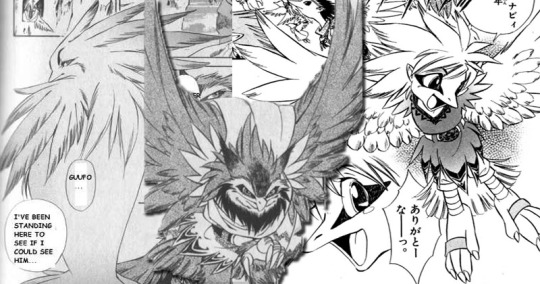
but for some reason the wind waker character designers got it in their heads that bird people had to be more person than bird, and also somehow that BEAKS were the one bird feature that had to remain on an otherwise human face and body.
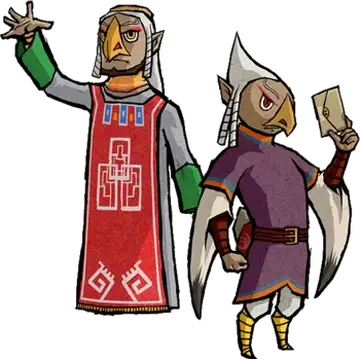
why did we do this. why do they still have human mouths underneath the beaks. why do they not have wings even though the one actual story-relevant implementation of this race involved one of them FLYING AROUND. who approved this
honorable mention to the horrible race of human-faced birds with human tits who make the worst noises known to man from twilight princess. someone needs to be executed for this
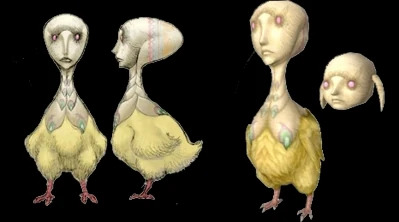
they FINALLY managed to get it ALMOST perfect in botw. somehow they went from human-faced titbird into World's Sexiest Parrot Man and managed not to fuck it up. This is why you need to hire furries if you're making an anthropomorphic nonhuman race. i guarantee if there had just been one single furry working on wind waker we would have gotten this 15 years sooner
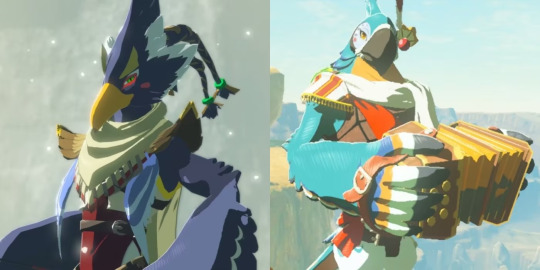
are the botw rito perfect? no. if i were designing them i would have gotten rid of the bird titties and made the female rito color-accurate to real birds but all in all this is an INSANE improvement considering where we started. please god just hire furries
#asks#god. me and the zelda character designers have a love-hate relationship. but if were being real it's mostly hate
240 notes
·
View notes
Text

The long-tailed titbirds (mésanges blanches) family is available on the french online shop, it's not japan exclusive anymore (I won't be getting them since I don't buy stuff online by choice)
(NSFW AND KINK ACCOUNTS DO NOT INTERACT !!!)
#sylvanian families#calico critters#toys#bird#furry#toy#toycore#doll#figure#dollhouse#cartoon#my art#artist on tumblr#art
8 notes
·
View notes
Text
MY KIAN STONE ASHTRAY HAS BEEN MADE
now i need to make a mug that says i love tits but instead of tits its the titbird
1 note
·
View note
Text
Accessibility Is More Than Ramps: Living with Invisible Disabilities

On Monday, I shared thoughts on the lived experience of disability. I unexpectedly received messages of gratitude from readers across the board. There is so much quiet hurt in the world—people feeling misunderstood, or navigating conversations about illness without care or compassion.
Yesterday, I had a conversation with a rehabilitation doctor. He asked whether I find it difficult to communicate what I go through as someone with an invisible disability. I explained that it’s not so much the ability to articulate it—that part, I’ve honed. The difficulty lies in being understood. People don’t always have the shared experience needed to grasp what the words truly mean. For example, chronic fatigue isn’t simply “being tired.” Tiredness can be resolved by rest. Chronic fatigue is unpredictable, invasive, and unrelenting.
I told him: the only way to bridge the gap is to shine a light on what invisible disabilities are, to inform the broader public about the challenges we face, and to make it part of our social conversation. Once we’ve done that—then ask me again if it’s hard to communicate what I go through.
More information and more visibility are urgently needed. And I’m more than willing to provide it. Today, I want to start by exploring what often goes unseen—what’s misunderstood, overlooked, or dismissed. Invisible disabilities can shape every aspect of a person’s life and may prevent full access to the world around them.
When people think of accessibility, they often picture ramps, lifts, or wide doorways. Those are vital—but accessibility goes far beyond bricks and concrete. For those of us living with invisible disabilities, access might mean flexibility with time. It might mean freedom from harsh lighting, loud noise, or overstimulating environments. It might mean understanding that energy is not just limited but also unpredictable, and that “pushing through” can have lasting consequences.
Access means being able to exist, participate, and belong—without having to constantly justify your needs.
In modern life, we’ve grown used to explaining how we feel, defending our thoughts, and using words to build bridges of understanding. But here’s the golden rule of communication: the message must be received and understood by the other person. If I tell you my dog has blue hair, but you don’t know what “blue” means, you’ll miss the point. So when I say that fatigue is a debilitating part of my condition, someone might hear “fatigue = tired,” and think, “I get tired too, but I push through and go to bed early—why can’t you do the same?”
That’s where miscommunication starts. And once misunderstanding sets in, it often leads to misplaced accountability and judgment.
We live in a culture that values performance and productivity. We hold people accountable for what they do—which, in many cases, is entirely reasonable. But what happens when someone is judged by standards shaped by assumptions? When a person is scrutinized for not working, simply because their disability isn’t visible? Or asked to explain why they can function one day and not the next?
The truth is, society isn’t designed with invisible challenges in mind. If your condition isn’t visible, many assume you’re fine. But this assumption erases the labor it takes just to show up. It dismisses the brain fog, the pain, the anxiety—and the constant effort to mask it all in order to be seen as “normal.”
And that masking itself is exhausting. The pressure to be believed, to seem capable, to avoid suspicion—it all adds to the weight we carry. It fuels stress, deepens isolation, and increases the distance between us and the world.
So how do we begin to make space for invisible disabilities? How do we make society more accessible?
It begins with a shift—from suspicion to trust. That’s not a small ask. In today’s world, it’s a paradigm shift. But it’s not about special treatment. It’s about equal footing. It’s about creating spaces where people don’t have to fight to be believed before they’re offered support.
How do we spark that shift? We start by listening. Without judgment. With open hearts. With a willingness to be wrong and to grow. We start by saying, “Even if I haven’t lived it, I believe you.” We start by giving people what they need to thrive—and valuing them for who they are, not for how much they produce.
Not everyone’s experience looks the same. But every voice deserves to be heard. Let’s listen to those voices. And let’s make space—for all of us.
If you enjoy reading my insights and would like to stay updated on my latest posts, please subscribe to my blog for email notifications. Subscription is free!
Source: Accessibility Is More Than Ramps: Living with Invisible Disabilities
0 notes
Text
Not even a Titbird...

It was flagged for being s*xually explicit.
Sir? Ma'am? My fellow denizen of the internet? That there is a bird.
229 notes
·
View notes
Text
titbird.
family: tit

0 notes
Text







#balticland_magic#birdfeeder#windowbirds#woodpecker#sparrows#titbirds#windowfeeder#feedingbirds#talesfrom_baltic
1 note
·
View note
Text
Kleines Vogelhaus für Balkon,Terrasse oder Garten. Aus Altholz und Resten hergestellt.......Upcycling Small bird house for the balcony, terrace or garden. Made from scrap wood and leftovers ....... Upcycling
#birdhouse#birdfeeder#vogelhaus#etsy#ebay#balkanwooddesign#upcycling#meise#spatzen#finken#finches#sparrow#titbird#vogel#bird#garten#balkon#terrasse#balkonygarden#gardendecoration#vogelfotografie#naturgarten#handcrafted#handarbeit#jardin#jardim#haus#house#holz#wood
7 notes
·
View notes
Text
First Cast



First cast and man, did it come out better than I expected! It gets such nice swirls in it, the detail is great and an unexpected benefit is the wings are thin enough that if I don’t make the color slightly see through it gets this gorgeous overlap of the feathers! I’m so happy I took the time to make those feathers overlap well; I hadn’t thought it mattered too much but I’m a stickler for details and it worked out well on this one. Can’t wait to make more!
#art#sculpture#bird#sfw#GREATTITBIRD#greattit#titbird#wildlife#resin#resincast#casting#resinart#Artists of Tumblr#support artists#artists on tumblr
4 notes
·
View notes
Text
Great Tit Bird | Species and Characteristics

Published Major: Tenuk Conservation Status: Green

Great Tit Bird Title: Excellent Title, All Birds, Cornell Lab of Ornithology Visible would you live, parks, gardens, and fences on agricultural land. Often visiting the chicken nutrients and using tits. The tile is special, with white pages that will circle a black and a bib test. The male has a black womb in its abdomen, while the female does not. The young ones, seen in summer and fall, have a yellow face. The persisters are in bright yellow in a lot of range, but the Central Asia "Tit Tit" has a white belly. Not possible to remove the adverb. Listen to their song from the top to the distinctions: "Tsee-Dee-Dee-Dee" and noises. Other Names: - Compunenser (Spanish) - Charbonnière (French) Interesting Facts - In 20th-century Europe, when milk was delivered in glass bottles, Great and Blue Eurasian tits learned to peck through the foil lids to access the cream. - The Great Tit has bright plumage and has adapted to avoid toxic prey by recognizing warning patterns. - During winter, they typically forage at around 7 meters (23 feet), but in spring, they reach up to 9 meters (30 feet) to find caterpillars. - Climate change has influenced the breeding season of Eurasian tits in Belgium. Between 1979 and 2007, as spring temperatures rose, both species started nesting two days earlier and produced fewer offspring each year. - The oldest recorded Great Tit lived for 15 years. Identification - The British Great Tit has a distinctive two-syllable song. - Its body is green and yellow with a black head and white cheek patches. - A woodland bird that has adapted well to gardens, making it a common visitor to bird feeders. - Can be aggressive at feeding stations, often dominating smaller tits. - In winter, it joins mixed flocks of Blue Tits and other species to forage. Regional changes Ornithologists know two important groups of supplies: "Great" and "Turocestan." You can find the "Great" group in Northeast Africa and Eastern Siberia. The "Turocestan" group is only in Central Asia. The main difference between the two groups is the color of the sharp breasts. The blue "therkestan" has white thresholds. The larger ones show strong changes throughout this group's range.

Habits of Tit Bird Habitat - Common in woodlands, urban areas, and agricultural lands. Physical Characteristics - Length: 14 cm - Weight: 18 g - Wingspan: 24 cm - Coloration: Green, blue, black, white, and yellow Conservation Status - Currently stable with no immediate threats. Habitat He also closed Europe, a university set in the lush woods, gardens, parks, and fields. I am home in open or anxious forests, especially those with Oak, than a wide dense forest. Gardens, parks, and cemeteries offer food opportunities. They help big chests find harp seeds, which are a good food source during winter. In some Asian regions, people limit Woody's habits. This includes parts of Western and Siberian areas. He often lives in groups of trees. Woody's diet is diverse, powered by insects. This includes adults, larvae, and eggs. Favorite insect groups include butterflies, beetles, leafcutter ants, and mint moths. They also eat other types of insects. In winter, seeds from bee and hazelnuts, along with fruits, become key food sources for insects. They also jump on the ground in search of invertebrates or seeds fell by trees. After finding food, birds often fly to their prey. They hold the insects with one or two feet and peck at them. Nurses tend to fallen nests that are big and bare inside. Some people take vacations, but old trees and natural trees grow in many buildings. Description of Nests The nest looks like a cup. It is made from dry vegetation held together by hair, wool, and feathers. Nesting Facts - Size: 3-18 Uggs - Number of Broods: 1–3 - Brooding Period: 12–15 days - Nesting Days: 16–22 days - Egg Description: White with reddish-brown markings. The Great Court is lively and loud. The males are particularly vocal, and sometimes the birds join in. Migration They often visit birds, and some brave individuals eat birdseed from human hands. I am also smart, especially taking advantage of a single food option. A British study found that these birds solved problems on their own. They used skills like the Lever of Levat and strings to get food from a bird puzzle. Great birds are rare among bird users. These birds use conifer needles to pull larvae from tree holes. Big Carms mate for life during a tough season. You can often find them where their species gathers. The female builds the nest and handles any incubation and spread. The herd size ranges from 3 to 18 eggs. The first group averages 9 to 11 eggs, but the second group usually has two eggs. Both parents feed the chicks, and they leave the nest after less than three weeks. Out of the breeding season, this species is social, with 15 to 50 tits both mixing with other small birds. Read the full article
0 notes
Text

A little gnome.
7 notes
·
View notes
Photo

We had our first snow this week. So excited! Sharing this illustration I made last winter :D
#titbird#winter#winteriscoming#winterishere#cute birds#birds_nature#cute illustration#cute animals#winter birds#female illustrators#Illustration#illustrator#bird watching#birdlovers#birdlady#snow#Digital Illustration#dailyinspiration#inspirationdaily#inspiredbynature#goodmood#mood of the day#Mood of Today#children's book illustration#illustrations#digital painting#editorial illustration#editorial#art#artofinstagram
7 notes
·
View notes
Photo

A Beautiful Black & White Bird, Cinereous Tit, playing around my house. More Information: The cinereous tit (Parus cinereus) is a species of bird in the tit family Paridae. This species is made up of several populations that were earlier treated as subspecies of the great tit (Parus major). These birds are grey backed with white undersides. The great tit in the new sense is distinguishable by the greenish-back and yellowish underside. The distribution of this species extends from parts of West Asia across South Asia and into Southeast Asia. #cinereoustit #paruscinereus #parusmajor #titbird #greytit #greattit #indiangreytitbird #tinybirds #songbird #birds #birdlife #birdlovers #birdwatcher #birdwatching #birdwatchers #birdsofindia #birdsofpunjab #birdsofindiansubcontinent #birdphotographersofindia #birdphotography #bird_watchers_daily #birdsofinstagram #bbcwildlifepotd #indianbirds #instabirds #naturephotography #wildlife #wildlifephotography #tarlokkumarphotography #canonshot (at Punjab India) https://www.instagram.com/p/CLM1JxyAARQ/?igshid=1pmowj0ct58qu
#cinereoustit#paruscinereus#parusmajor#titbird#greytit#greattit#indiangreytitbird#tinybirds#songbird#birds#birdlife#birdlovers#birdwatcher#birdwatching#birdwatchers#birdsofindia#birdsofpunjab#birdsofindiansubcontinent#birdphotographersofindia#birdphotography#bird_watchers_daily#birdsofinstagram#bbcwildlifepotd#indianbirds#instabirds#naturephotography#wildlife#wildlifephotography#tarlokkumarphotography#canonshot
0 notes
Photo
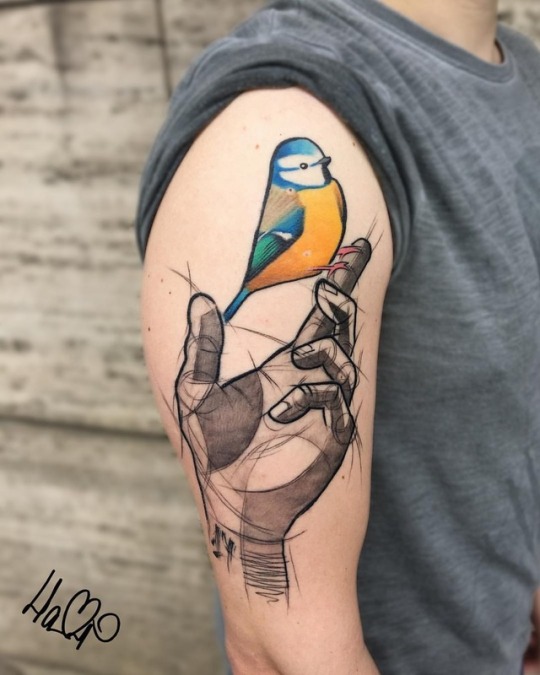
#tattoo #colortattoo #healedtattoo #handtattoo #tittattoo #titbird #cinege #hamitattoo #worldfamousink #eternalink #mickysharpzmachines #equalizerrotary #kisfonoktattoosupply #amsterdamtattoo #tribalactparis (helyszín: Tattoo Face)
#handtattoo#tattoo#tittattoo#cinege#hamitattoo#equalizerrotary#amsterdamtattoo#healedtattoo#worldfamousink#eternalink#titbird#mickysharpzmachines#tribalactparis#kisfonoktattoosupply#colortattoo
1 note
·
View note